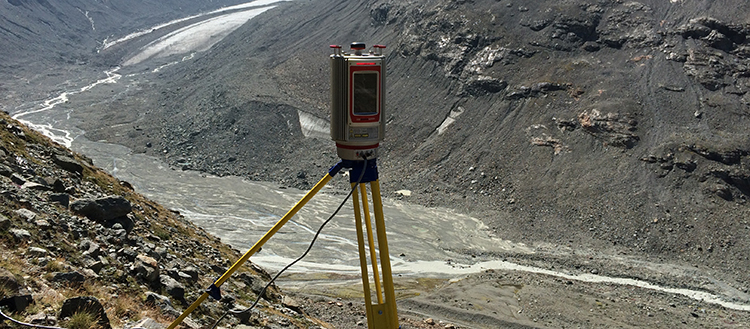Sediments in Lake Geneva reflect the 2008 financial crisis

A Lidar device set near the Cabane de Bertol (VS) performs 3D laser scanning to measure the height of sediments in the Borgne d’Arolla riverbed (bottom of the picture) and records the retreat of the Arolla glacier (top). © Stuart Lane / Université de Lausanne
An analysis of sediment transport in the Rhône Valley yields surprising results: melting glaciers overcompensated for the effect of the increased number of hydropower plants. A reduction in construction activities due to the 2008 financial crisis could also be seen in the data. This comprehensive study, the first of its kind in Europe, brings important new knowledge, in particular for flood prevention.
Water carries sediments – from mud particles to gravel – which settle down in rivers, lakes and seas. This sedimentation plays a crucial role in flood prevention, hydropower production and ecosystems, but how it is affected by climate change in particular was not well known until now.
Research funded by the Swiss National Science Foundation (SNSF) has generated for the first time comprehensive knowledge of how sedimentation in Lake Geneva and the upstream Rhône Valley has evolved since the 1960s. It shows the impact of climate change, construction activities and hydroelectric power production. “What we did is a sort of life-cycle analysis of sediments in a very large river basin, and it’s the first of its kind in Europe,” says Stuart Lane from the University of Lausanne, first author of the article published in Scientific Reports. The multidisciplinary work brought together scientists from the universities of Lausanne, Bern and Geneva as well as ETH Zurich.
Accelerated sedimentation
The study reveals that a shift occurred in the 1980s, when sedimentation rates in Lake Geneva stopped decreasing and started to grow; they have more than doubled since then. This came as a surprise for the scientists: as dams block the transport of sediments, the growing number of hydroelectric plants in the Alps was expected to reduce the rate at which sediments accumulate in Lake Geneva. But particulate matter still travels downstream, either via rivers without hydropower or through dedicated structures that allow for the flushing of sediments downstream, avoiding dams. In addition, more sediment is being delivered from retreating glaciers. “They usually act as huge reservoirs, but their melting, induced by climate change, brings additional sediments into streams and rivers,” explains Fritz Schlunegger from the University of Bern, who led the project.
Another surprise: the scientists observed a peak in the sediment delivery since 2008, which they could trace back to reduced construction activity related to the global financial crisis. “In Valais, companies extract sand and gravel from the Rhône River for building material such as concrete,” Lane explains. “When they reduced their extraction activities, more sediment reached Lake Geneva, which is clearly visible in our data.”
“Our results show that sedimentation is best analysed within the framework of what the business world terms ‘glocalization’,” says Lane. “It can only be understood as a combination of global phenomena – here climate change and the 2008 international financial crisis – and local factors such as hydroelectricity production and construction activities. Without careful analysis, global factors can sometimes remain hidden behind local ones.”
Drones and cores
The researchers combined several techniques to analyse the evolution of sedimentation in the Rhône Valley. Scientists from the University of Geneva extracted sediment cores at the bottom of the lake and dated them via radio-isotopic analyses of Caesium, whose traces are related to past nuclear explosions. The Lausanne team recorded sediment production by glaciers and the movement of the sediments through rivers and pipelines, either with cameras measuring water turbidity or with the help of drones that mapped the height of dry river beds. They also analysed historical data provided by the Canton of Valais and hydropower companies. Colleagues from the University of Bern determined erosion rates and the geographical origins of the samples via geochemical analyses. Scientists at ETH Zurich performed statistical analyses of the historical data provided by Meteosuissse and the Federal Office for the Environment.
Preventing floods
Sedimentation plays an important role in different ways. Animals living in riverbeds are adapted to certain quantities of sediments and can suffer from sudden changes. Particulate matter accumulates behind dams and has to be removed before water is transferred in pipelines to other plants in different valleys; this reduces the water capacity for hydroelectrical production, with consequent loss of revenue. Finally, sediment raises the riverbed and thereby the water level of rivers; this increases the risks of flooding, especially as a sudden increased water flow brings even more matter that settles down in rivers flowing in a flat landscape. This occurred during the catastrophic floods of 1993 in Brig and in 2011 in Valais and central Switzerland. Knowledge about sedimentation in Valais is especially important with regard to the third correction of the Rhône, which aims at restoration the river and creating a wider floodable area.
This study is a collaboration between the Institute of Earth Surface Dynamics of the University of Lausanne, the Department of Civil, Environmental and Geomatic Engineering of ETH Zurich, the Department of Earth Sciences, the Institute for Environmental Science and the Department F.-A. Forel for Environmental and Aquatic Sciences of the University of Geneva, and the Institute of Geological Sciences of the University of Bern. It was funded by the Swiss National Science Foundation.
2 Jul 2019